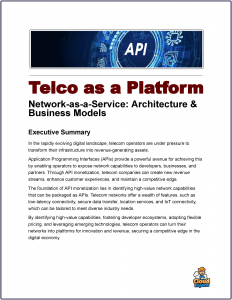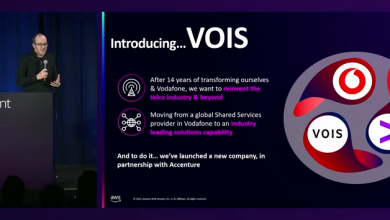 The adoption of network APIs allows telecom operators (telcos) to transform from traditional connectivity providers into platform-based businesses, unlocking new revenue streams, fostering innovation, and enhancing customer experiences.
The adoption of network APIs allows telecom operators (telcos) to transform from traditional connectivity providers into platform-based businesses, unlocking new revenue streams, fostering innovation, and enhancing customer experiences.
By exposing network capabilities through standardized, programmable interfaces, telcos can create ecosystems that connect developers, enterprises, and partners, positioning themselves as central players in the digital economy.
API monetization offers telcos a path to diversify revenue and establish platform business models by leveraging network capabilities.
Strategies like pay-per-use, subscriptions, freemium, revenue sharing, value-based pricing, bundling, and marketplace fees cater to different use cases and customer segments. Success hinges on balancing accessibility with profitability, investing in developer-friendly ecosystems, and aligning with industry standards.
By experimenting with these models and learning from early adopters, telcos can unlock significant value from network APIs, positioning themselves as pivotal players in the digital economy.
How Network APIs Enable Platform Business Models
Network APIs (e.g., those standardized by initiatives like GSMA Open Gateway or CAMARA) provide programmatic access to telco network functionalities, such as quality-of-service (QoS) on-demand, location services, authentication, edge computing, and billing capabilities.
Unlike traditional telecom services, which focus on selling connectivity (e.g., voice, data plans), APIs allow telcos to modularize and monetize network features as services that developers and businesses can integrate into their applications. This shift aligns with the characteristics of platform business models, which:
- Facilitate Interactions: Platforms connect multiple parties (e.g., developers, enterprises, and end-users) to create value through interactions.
- Leverage Ecosystems: They thrive on network effects, where the value grows as more participants join (e.g., more developers create apps, attracting more users).
- Enable Scalability: APIs provide standardized, reusable interfaces that scale across industries and use cases.
By adopting network APIs, telcos can move beyond linear, infrastructure-heavy business models and act as enablers of digital ecosystems, akin to cloud providers (e.g., AWS) or tech platforms (e.g., Google, Apple). This transition allows telcos to capture value not just from connectivity but from enabling innovative services across sectors like finance, healthcare, gaming, and IoT.
Market Opportunities for Telcos
Here are the specific opportunities network APIs present for telcos to pioneer platform business models, along with their potential benefits and examples:
Monetizing Network Capabilities as a Service
Telcos can package network features (e.g., low-latency connections, device authentication, or real-time location data) as APIs and charge developers or enterprises for access on a pay-per-use or subscription basis.
This diversifies revenue beyond traditional subscriptions, tapping into B2B and B2B2C markets, and enables premium pricing for differentiated services, such as guaranteed QoS for gaming or video streaming.
- QoS APIs: Telcos like Verizon or Deutsche Telekom could offer APIs for dynamic bandwidth allocation, enabling developers to ensure low-latency experiences for cloud gaming or AR/VR apps.
- Number Verification APIs: APIs for SIM-based authentication could be used by fintech apps for secure logins, with telcos earning per transaction.
- Edge Computing APIs: Telcos can expose edge nodes for processing IoT or AI workloads, charging based on compute usage.
Creating Developer Ecosystems
Telcos can build developer portals (similar to AWS or Twilio) where third-party developers access APIs, documentation, and sandboxes to create innovative applications.
- Attracts a global developer community, driving innovation and increasing API adoption.
- Creates network effects: more apps built on telco APIs attract more users, which in turn draws more developers.
A telco like AT&T could launch a portal offering APIs for IoT device management, enabling developers to build smart city solutions (e.g., traffic monitoring). GSMA Open Gateway’s standardized APIs allow developers to create apps that work across multiple telcos, reducing fragmentation and encouraging adoption.
Enabling Industry-Specific Solutions
Opportunity: Telcos can use APIs to co-create tailored solutions for verticals like healthcare, automotive, or retail, positioning their platforms as industry enablers.
Strengthens B2B relationships by addressing specific pain points (e.g., secure connectivity for telemedicine).
Positions telcos as strategic partners rather than commodity providers.
- Healthcare: APIs for secure, high-quality video calls could power telemedicine platforms, with telcos earning revenue per session.
- Automotive: Location and QoS APIs could support connected car services, such as real-time navigation or remote diagnostics.
- Retail: Device status APIs could enable retailers to verify customer identities for in-store pickups, reducing fraud.
Facilitating Partnerships and Hyperscaler Integration
Opportunity: Telcos can integrate their APIs with hyperscalers (e.g., AWS, Azure) or partner with OTT players (e.g., Netflix, Spotify) to embed network capabilities into broader ecosystems. Expands market reach through hyperscaler marketplaces, where enterprises already procure services.
Enhances customer experiences by enabling seamless, high-quality services for OTT applications. A telco could integrate its QoS APIs with AWS, allowing enterprises to dynamically adjust connectivity for cloud-based workloads. Partnering with a streaming service to provide “zero-latency” APIs for live events, with revenue-sharing models.
Supporting 5G and Emerging Technology Use Cases
APIs can unlock 5G’s potential by exposing capabilities like ultra-low latency, network slicing, and massive IoT connectivity, enabling telcos to power next-gen applications.Justifies 5G infrastructure investments by creating new revenue streams. Positions telcos as leaders in emerging tech markets like metaverse, autonomous vehicles, and smart factories.
- Network Slicing APIs: Telcos could offer APIs to allocate dedicated network slices for industrial IoT, ensuring reliable connectivity for factory automation.
- AR/VR APIs: APIs for low-latency 5G connections could support immersive metaverse experiences, with telcos charging developers per user session.
Simplifying Enterprise Digital Transformation
Opportunity: Telcos can offer APIs that streamline enterprise processes, such as billing, fraud prevention, or customer verification, acting as a one-stop platform for digital services. This reduces enterprise development costs and time-to-market.
Creates sticky relationships, as enterprises rely on telco platforms for critical operations. Billing APIs: Telcos could enable direct carrier billing for app purchases, earning a percentage of each transaction.
Fraud Detection APIs: APIs analyzing call patterns or device behavior could help banks detect fraud, with telcos monetizing per query.
Building Aggregator Platforms
Telcos can create API marketplaces that aggregate capabilities from multiple operators, providing a unified interface for developers to access global network services.
This solves the fragmentation challenge, as developers can use one platform instead of negotiating with individual telcos, and positions telcos as orchestrators of the telecom ecosystem, capturing value from transactions.
A consortium like GSMA could run an API marketplace where developers access location APIs from multiple telcos, with revenue shared among operators. A telco like Vodafone could aggregate IoT APIs, enabling global enterprises to manage devices across regions seamlessly.
Challenges to Overcome
While the opportunities are significant, telcos must address several challenges to succeed as platform providers:
Standardization and Interoperability: Fragmented APIs across operators can deter developers. Initiatives like GSMA Open Gateway and CAMARA are critical for creating universal standards.
- Developer Adoption: Telcos must compete with established platforms (e.g., Twilio, AWS) by offering compelling APIs, competitive pricing, and robust support.
- Cultural Shift: Moving to a platform model requires telcos to adopt agile, developer-centric mindsets, which may clash with traditional telecom operations.
- Security and Privacy: Exposing network capabilities raises concerns about data protection and compliance (e.g., GDPR), requiring robust safeguards.
- Monetization Models: Telcos must balance free tiers to attract developers with paid models to ensure profitability, avoiding overly complex pricing that could discourage adoption.
Strategic Recommendations
To capitalize on these opportunities, telcos should:
- Invest in Developer Experience: Create intuitive portals with clear documentation, SDKs, and sandboxes to attract developers.
- Collaborate on Standards: Support initiatives like GSMA Open Gateway to ensure APIs are interoperable and scalable globally.
- Partner Strategically: Work with hyperscalers, OTT players, and industry verticals to embed APIs into existing ecosystems.
- Experiment with Pricing: Offer flexible models (e.g., freemium, pay-per-use, revenue-sharing) to encourage adoption while ensuring revenue.
- Showcase Use Cases: Demonstrate API value through proofs-of-concept in high-impact sectors like IoT, gaming, or healthcare to build momentum.
Conclusion
Network APIs present telcos with a transformative opportunity to pioneer platform business models, shifting from connectivity providers to ecosystem enablers. By monetizing network capabilities, fostering developer ecosystems, enabling industry solutions, and leveraging 5G, telcos can unlock new revenue streams and strengthen their relevance in the digital economy.
Success will depend on standardization, developer engagement, and strategic partnerships. Telcos that act decisively to build scalable, developer-friendly platforms can position themselves as leaders in the next wave of digital innovation.



